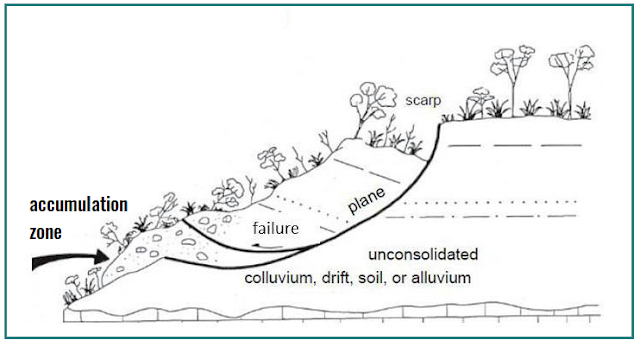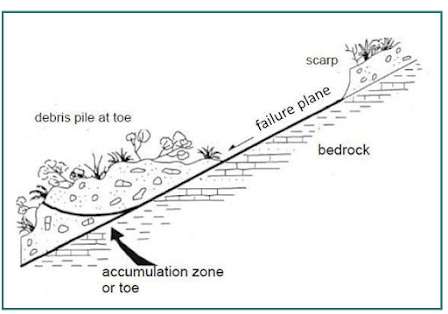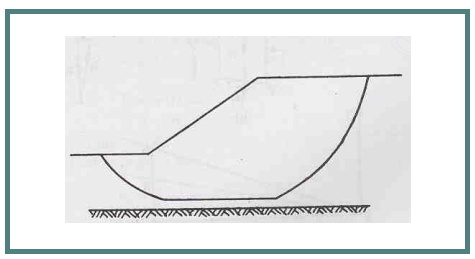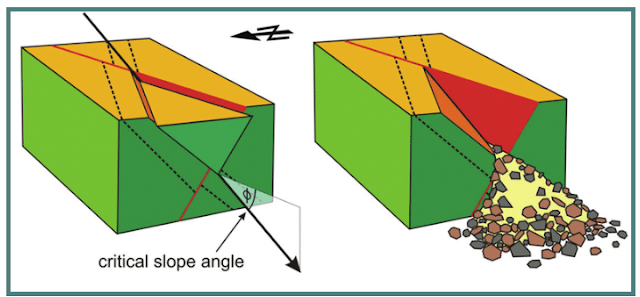Search This Blog
Most Popular
Categories
- Building Construction (87)
- Building Materials (85)
- Columns (2)
- Concrete Beam (3)
- Concrete Construction Techniques (6)
- Concrete Mix Design (14)
- Concrete Repair (14)
- Concrete Slab (11)
- Construction Equipment (17)
- Construction News (7)
- Design of Structures (18)
- Engineering Drawing (1)
- Estimation (3)
- Geotechnical engineering (26)
- Highway Engineering (11)
- Innovations (34)
- Material Testing (10)
- Matrix Analysis of Structures (2)
- Mechanical Engineering (3)
- Strength of Materials (2)
- Structural Analysis (13)
- Structural Design (24)
- Structures (17)
- Transportation Engineering (9)
Types of Slope Failures
Team Prodyogi
July 24, 2023
Slope stability is defined as the potential of naturally occurring or engineered soil slopes to withstand ground movement. A slope in geotechnical engineering refers to a soil mass that is inclined horizontally. This slope can be a natural slope ( valleys) or a man-made slope/engineered( embankments of railways, earth dams, levees, etc).
The construction of man-made slopes and related applications requires the study of both slope failure and slope stability.
In this article, we discuss how soil fail, types of soil slope failures leading, and the need for stability analysis of slopes.
Stability of Slopes and Failure of Slopes
The stability of slopes refers to the ability of a slope or an inclined surface to resist failure or collapse. It is a measure of the balance between the forces acting on the slope and the strength of the materials comprising the slope. When a slope is stable, it can withstand various internal and external forces without undergoing excessive deformation or failure.
A slope failure occurs when there is downward and outward movement of a portion of the slope also called sliding soil mass. When this occurs naturally, we call it a landslide that ought to be a natural calamity. When we decide to construct any structure or human space nearby such areas we have to check the slope stability or sufficient earth retaining structures to ensure safe usage.
We study the theory of stability of slopes for constructing various structures to ensure their safety and stability. This study is called stability analysis where the necessary study and analysis are performed to investigate potential failure mechanisms and sensitivity to various triggering mechanisms. Hence, slope stability analysis involves the design of optimal slopes considering safety, reliability and economics, and possible remedial measures.
Most earth retaining structures like retaining walls, earth dams, road embankments, or construction operations like excavations and cut slopes, mining operations, etc are performed by geotechnical engineers who can analyze the safe stability of the slope.
How Slopes Fail?
Before moving on to types of earth slopes, it is necessary to understand how soil slopes fail. The failure of a soil mass occurs along a plane or a curved surface when a large mass of soil slides concerning the remaining mass.Generally, there is a downward and outward movement of the soil mass. A slope failure occurs when the forces (shear forces) causing the failure are greater than the shear resistance or shear strength developed along the critical surface of the failure. This situation can occur in either of the following cases:
- Failure of the slope when the shear forces acting on the soil slope are increased due to the weight of water ( saturating the soil), surcharge loads, seepage pressure, or other causes like increased steepening of slope due to excavation works or natural erosion.
- Failure of the slope when the soil loses its shear strength due to excessive water content, increased pore pressure, weathering, shock or cyclic loads, or other causes.
Types of Slope Failure
A slope may undergo any one of the following failures:
- Rotational Failures
- Translational Failures
- Compound Failures
- Wedge Failure
- Miscellaneous Failures
1. Rotational Failure
 |
| Rotational Failure in Slopes |
This type of failure occurs by rotation along a slip surface by downward and outward movement of the soil mass as shown below. Rotational failure can be a toe, face, or base failure.
 |
| Types of Rotational Failure in Slopes Image Credits: Potter, 2007 "Exploring the geology of Cincinnati", Kentucky Geological Survey |
A toe failure is a type of failure where the slip surface passes through the toe. This failure condition occurs when a stratum relatively strong compared to the top layers occurs at the toe level.
A Face failure occurs when the slip surface cuts the surface of the slope above the toe. This failure condition occurs when a stratum is relatively strong compared to other layers and occurs above the toe level.
A base failure occurs when the slip surface passes below the toe. This type of failure condition occurs when a stratum relatively stronger than the other layers exists below the toe level.
2. Translational Failure
 |
| Translational Failure in Slopes Image Credits: Potter, 2007 "Exploring the geology of Cincinnati", Kentucky Geological Survey |
Translation failure occurs along a failure surface parallel to the slope as shown in the figure below. It mainly occurs in an infinite slope.
The shape of the translational failure surface is influenced by the presence of any hard stratum at a shallow depth below the slope surface. It is also observed along the slope with layered materials.
3. Compound Failure
Compound failure is a combination of rotational and translational failure of slopes. A compound failure surface is curved at the two ends and plane in the middle portion.
 |
| Compound Failure of Soil Slopes |
A compound failure occurs when a hard stratum exists at a considerable depth below the toe.
4. Wedge Failure
 |
| Wedge Failure in Slopes |
Wedge failure occurs in slope distinct blocks and wedges of the soil mass become separated. This failure occurs along an inclined plane and is hence also called a plane failure or block failure.
A plane failure is similar to translational failure but instead of infinite slopes, plane failure occurs in finite slopes that is made of two different materials or on a homogeneous slope with cracks, fissures, joints, or other specific plane of weakness.
Summary
The stability of a slope is influenced by several factors, including the characteristics of the soil or rock materials, groundwater conditions, slope geometry (such as slope angle and shape), and external forces like rainfall, seismic activity, or human activities. By analyzing these factors, geotechnical engineers can assess the stability of a slope and determine the likelihood of slope failure.Slope stability analysis involves evaluating factors such as the shear strength of the soil or rock, the presence of potential failure surfaces or planes, and the loads acting on the slope. Various methods and techniques, such as limit equilibrium analysis, numerical modeling, and field investigations, are used to assess and predict the stability of slopes.
The study of slope stability is crucial in geotechnical engineering to prevent landslides, design safe structures, and ensure the safety of people, infrastructure, and the environment. By understanding the stability of slopes, engineers can implement appropriate measures to mitigate risks and enhance the stability of slopes in various engineering projects.
Read More On: Types of Failure in Soils in Construction
Most Visited
Soil Sampling Methods| Undisturbed and Disturbed Samples
November 08, 2023
What are Infiltration Wells?
April 15, 2024
Boring Methods for Soil Exploration
November 02, 2023
How to Choose Good Quality Aggregates for Construction?
August 10, 2021
Steel Column Connected to Concrete Masonry Wall
October 11, 2017
How to Calculate Cement Required for Floor Tiling?
July 02, 2020
Terzaghi's Equation: Soil Bearing Capacity for Foundations
March 02, 2022
Search This Blog
MUST READ
What is PERT? Objectives, Pros & Cons
September 10, 2017
Terzaghi's Equation: Soil Bearing Capacity for Foundations
March 02, 2022
Contact Form
Footer Menu Widget
Created By SoraTemplates | Distributed By Gooyaabi Templates


0 Comments
Commenting Spam Links Are Against Policies